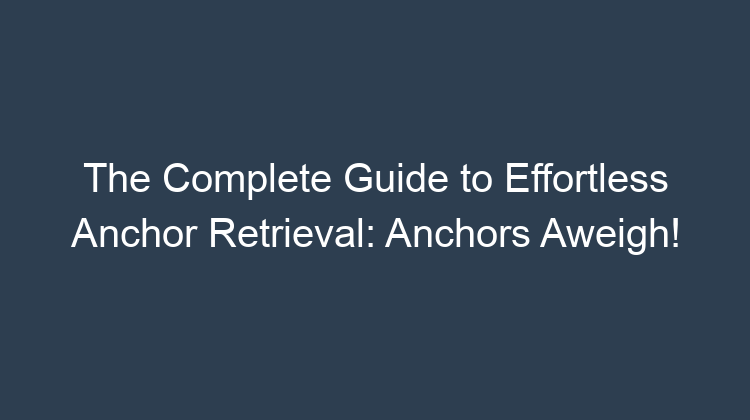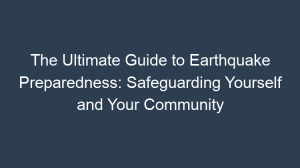Anchoring your boat is a crucial skill for any boater to master. Whether you’re looking to drop your hook for a quick fishing trip or settling down for an overnight stay, knowing the best way to retrieve an anchor is paramount. This comprehensive guide will equip you with all the essential information you need to ensure a hassle-free anchor retrieval process, granting you peace of mind during your aquatic adventures.
It delves into the various retrieval techniques tailored to different anchoring scenarios, equipping you with the know-how to handle diverse situations with confidence. Moreover, it explores the critical factors such as water depth, wind conditions, and bottom composition that influence the choice of anchoring method, ensuring you make informed decisions to secure your vessel effectively.
Anchor retrieval is a key aspect of boating that requires skill and attention to detail. This guide is designed to provide you with comprehensive knowledge on how to retrieve an anchor efficiently and safely. Whether you’re a seasoned boater or just starting out, the following sections will guide you through various anchor types, techniques, and tips to ensure a successful retrieval every time.
Factors to Consider for Successful Anchor Retrieval
Anchor Type:
The type of anchor you use plays a crucial role in determining its retrieval ease. Common anchor types include the Danforth, CQR, and fluke anchors. Each type has unique characteristics and is suitable for different bottom conditions. Choosing the right anchor is essential for a secure hold and hassle-free retrieval.
Water Depth:
The depth of the water you’re anchoring in influences the anchor retrieval process. In deeper waters, retrieving an anchor can be more challenging due to the increased weight of the anchor line. Understanding the water depth is crucial for selecting the appropriate retrieval technique and ensuring a successful recovery.
Wind Conditions:
Wind conditions can significantly impact the anchor retrieval process. Strong winds can create a pull on the anchor, making it more difficult to retrieve. Consider the wind direction and strength before anchoring and anticipate potential challenges during retrieval to ensure a safe and efficient process.
Techniques for Hassle-Free Anchor Retrieval
Vertical Retrieval:
The vertical retrieval method involves pulling the anchor straight up from the bottom. This technique is often used with anchors set in shallow water or when the anchor is fouled on the bottom. To perform a vertical retrieval, use a capstan or a manual windlass to pull the anchor line slowly and steadily, ensuring the anchor doesn’t get stuck or entangled.
Horizontal Retrieval:
Horizontal retrieval is suitable for deep water anchoring or when the anchor is set in a strong current. This technique involves using a boat’s engine to move the boat horizontally while slowly pulling the anchor line. The boat’s movement helps reduce the strain on the anchor line and makes the retrieval process more manageable.
Rolling Retrieval:
Rolling retrieval is a technique used when the anchor is set in a rocky or weedy bottom. This method involves pulling the anchor line slowly while moving the boat in a circular motion. The rolling motion helps dislodge the anchor from the bottom, making it easier to retrieve. Be careful not to pull the line too quickly, as this can cause the anchor to snap out of the bottom.
Tips for a Seamless Anchor Retrieval Experience
Use a Quality Anchor Line:
Invest in a high-quality anchor line made of durable materials such as nylon or polyester. A good anchor line should be strong enough to withstand the weight of the anchor and the boat, providing reliable performance during retrieval.
Choose the Right Anchor Size:
Selecting the correct anchor size is crucial for effective anchoring and retrieval. The size of the anchor should be appropriate for the size and weight of your boat. Using an undersized anchor can lead to insufficient holding power, while an oversized anchor can be difficult to retrieve.
Regularly Inspect Your Anchoring System:
Regularly inspect your anchoring system, including the anchor, line, and windlass, to ensure everything is in good working condition. This simple maintenance practice can prevent unexpected issues during anchor retrieval and enhance the overall safety of your boating experience.
FAQs about Retrieving an Anchor
How can I prevent my anchor from getting stuck?
To prevent your anchor from getting stuck, choose the right anchor type for the bottom condition and ensure it’s set properly. Use a sufficient amount of anchor line and avoid anchoring in areas with obstructions or dense vegetation.
What should I do if my anchor gets stuck?
If your anchor gets stuck, try moving the boat back and forth over the anchor to dislodge it. You can also try using a grapple or an anchor puller to help free the anchor. In extreme cases, you may need to cut the anchor line and leave the anchor behind.
How can I make anchor retrieval easier?
To make anchor retrieval easier, use a windlass or capstan to pull the anchor line. Choose an anchor that is easy to set and retrieve and make sure you have enough anchor line for the depth of the water. Additionally, avoid anchoring in areas with strong currents or obstructions.
What safety precautions should I take when retrieving an anchor?
When retrieving an anchor, always wear appropriate safety gear such as a life jacket and gloves. Be aware of other boats in the area and avoid swinging the anchor into them. Ensure that the anchor line is clear of obstructions before pulling it in.
How can I tell if my anchor is set properly?
To check if your anchor is set properly, slowly pull on the anchor line. If you feel resistance, the anchor is likely set. You can also check the angle of the anchor line to ensure it is not too steep or too shallow. If the anchor is not set properly, it may not hold your boat securely.
Conclusion
Mastering the art of anchor retrieval is a fundamental skill that every boater should possess. By understanding the factors influencing retrieval, selecting the appropriate technique, and employing practical tips, you can ensure a seamless and successful anchor retrieval experience. Remember to prioritize safety during the process, and with practice, you’ll develop the confidence and expertise to handle any anchoring situation like a seasoned mariner.







